SUBARU BRZ 2013 1.G Owners Manual
Manufacturer: SUBARU, Model Year: 2013, Model line: BRZ, Model: SUBARU BRZ 2013 1.GPages: 484, PDF Size: 6.46 MB
Page 131 of 484
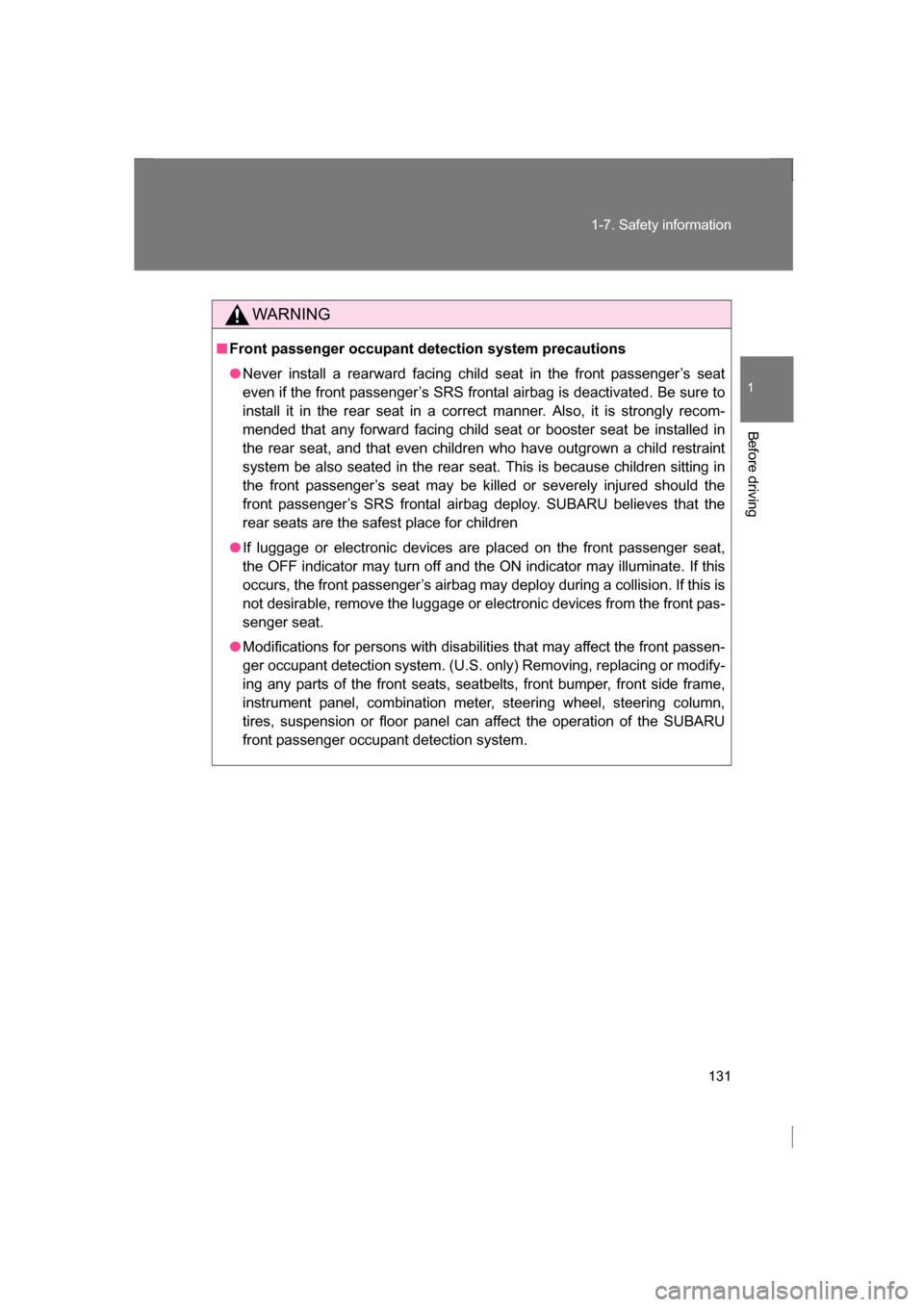
131
1-7. Safety information
1
Before driving
WARNING
■Front passenger occupant detection system precautions
●Never install a rearward facing child seat in the front passenger’s seat
even if the front passenger’s SRS frontal airbag is deactivated. Be sure to
install it in the rear seat in a correct manner. Also, it is strongly recom-
mended that any forward facing child seat or booster seat be installed in
the rear seat, and that even children who have outgrown a child restraint
system be also seated in the rear seat. This is because children sitting in
the front passenger’s seat may be killed or severely injured should the
front passenger’s SRS frontal airbag deploy. SUBARU believes that the
rear seats are the safest place for children
●If luggage or electronic devices are placed on the front passenger seat,
the OFF indicator may turn off and the ON indicator may illuminate. If this
occurs, the front passenger’s airbag may deploy during a collision. If this is
not desirable, remove the luggage or el ectronic devices from the front pas-
senger seat.
●Modifications for persons with disabilities that may affect the front passen-
ger occupant detection system. (U.S. only) Removing, replacing or modify-
ing any parts of the front seats, seatbelts, front bumper, front side frame,
instrument panel, combination meter, steering wheel, steering column,
tires, suspension or floor panel can affect the operation of the SUBARU
front passenger occupant detection system.
Page 132 of 484
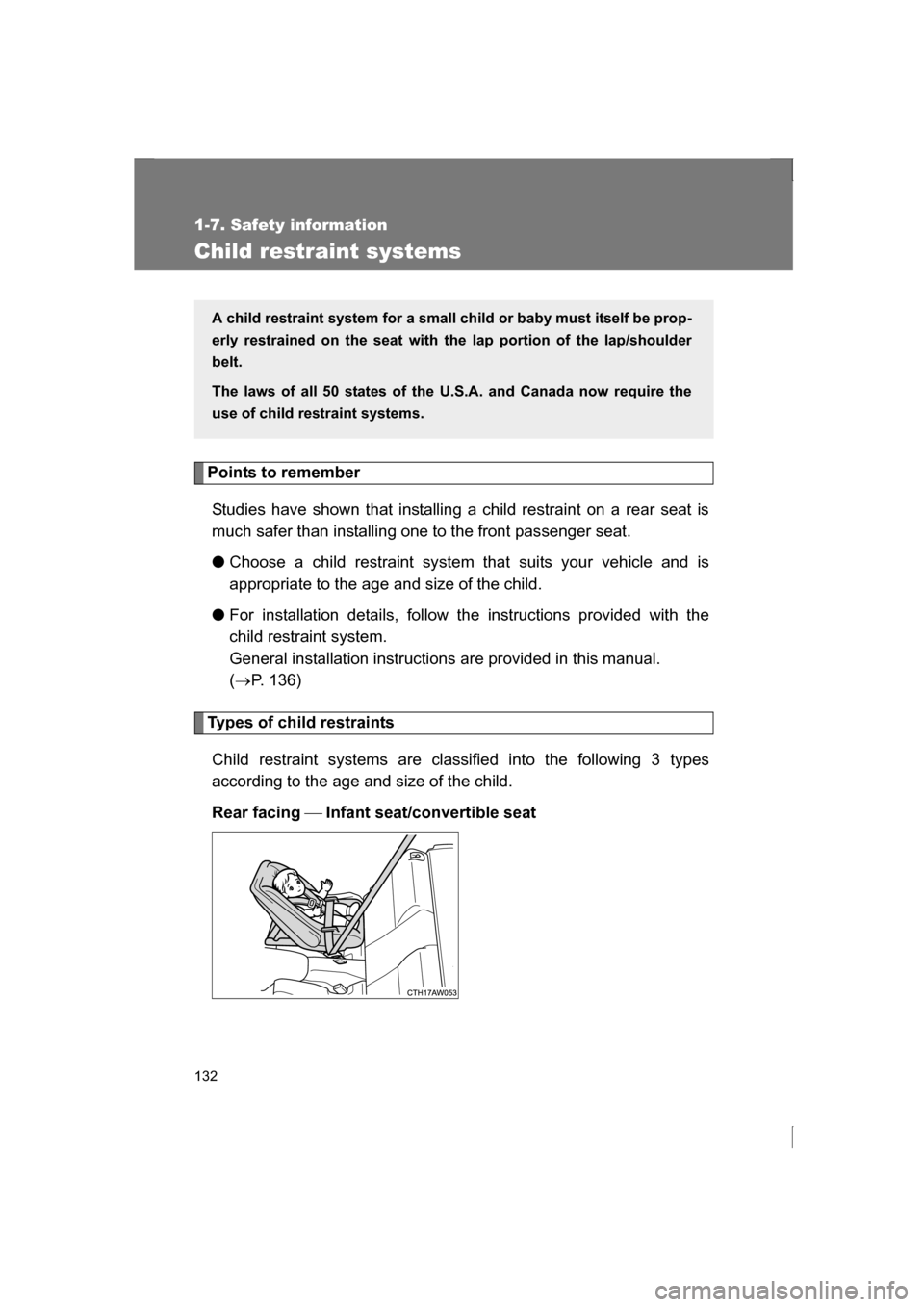
132
1-7. Safety information
Child restraint systems
Points to rememberStudies have shown that installing a child restraint on a rear seat is
much safer than installing one to the front passenger seat. ● Choose a child restraint system that suits your vehicle and is
appropriate to the age and size of the child.
● For installation details, follow the instructions provided with the
child restraint system.
General installation instructions are provided in this manual. (→ P. 136)
Types of child restraints
Child restraint systems are classified into the following 3 types
according to the age and size of the child.
Rear facing Infant seat/convertible seat
A child restraint system fo r a small child or baby must itself be prop-
erly restrained on the seat with the lap portion of the lap/shoulder
belt.
The laws of all 50 states of the U.S.A. and Canada now require the
use of child restraint systems.
Page 133 of 484
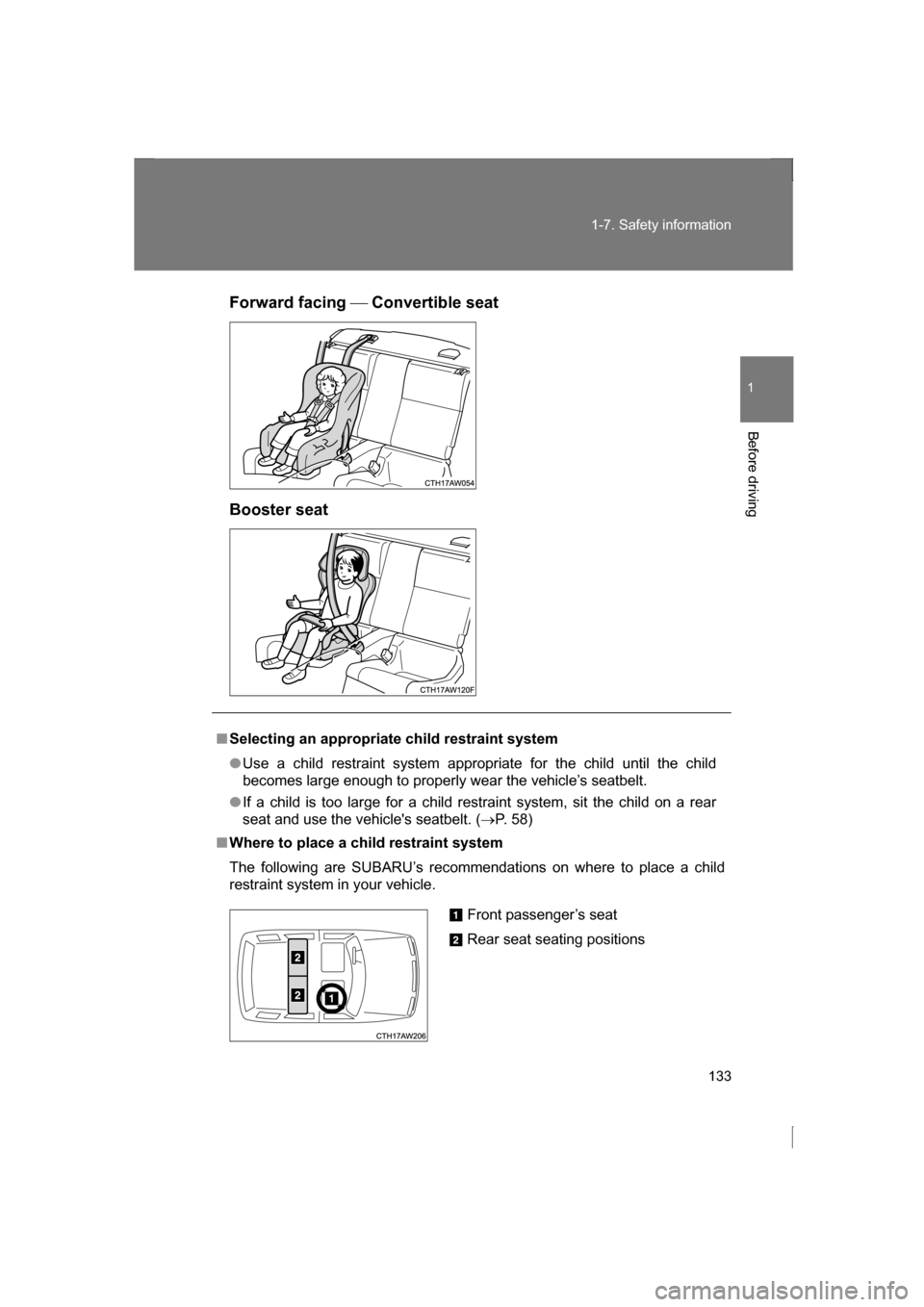
133
1-7. Safety information
1
Before driving
Forward facing Convertible seat
Booster seat
■Selecting an appropriate child restraint system
●Use a child restraint system appropriate for the child until the child
becomes large enough to properly wear the vehicle’s seatbelt.
●If a child is too large for a child restraint system, sit the child on a rear
seat and use the vehicle's seatbelt. ( →P. 58)
■Where to place a child restraint system
The following are SUBARU’s recommendations on where to place a child
restraint system in your vehicle.
Front passenger’s seat
Rear seat seating positions
Page 134 of 484
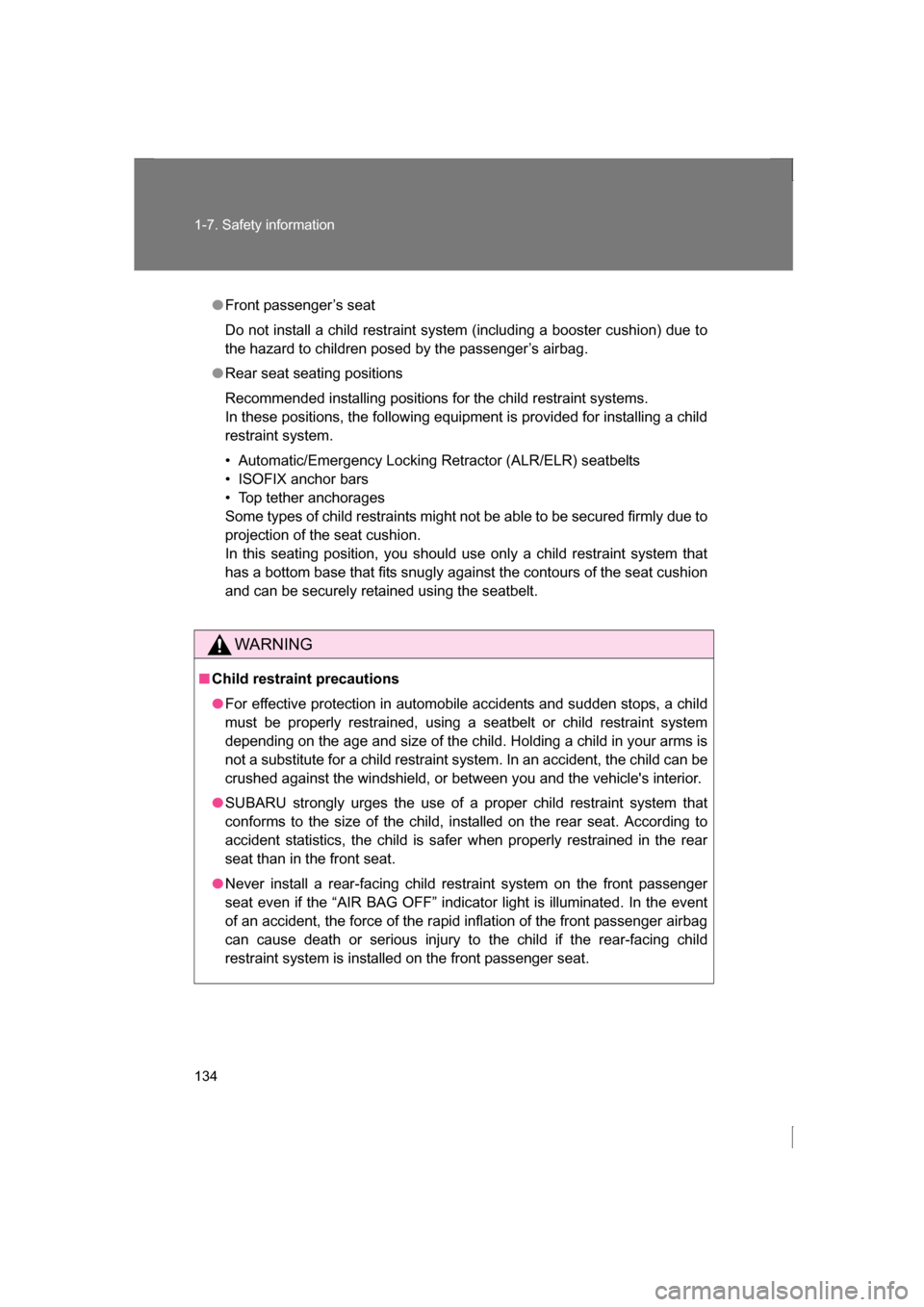
134
1-7. Safety information
●Front passenger’s seat
Do not install a child restraint system (including a booster cushion) due to
the hazard to children posed by the passenger’s airbag.
●Rear seat seating positions
Recommended installing positions for the child restraint systems.
In these positions, the following equipment is provided for installing a child
restraint system.
Page 135 of 484
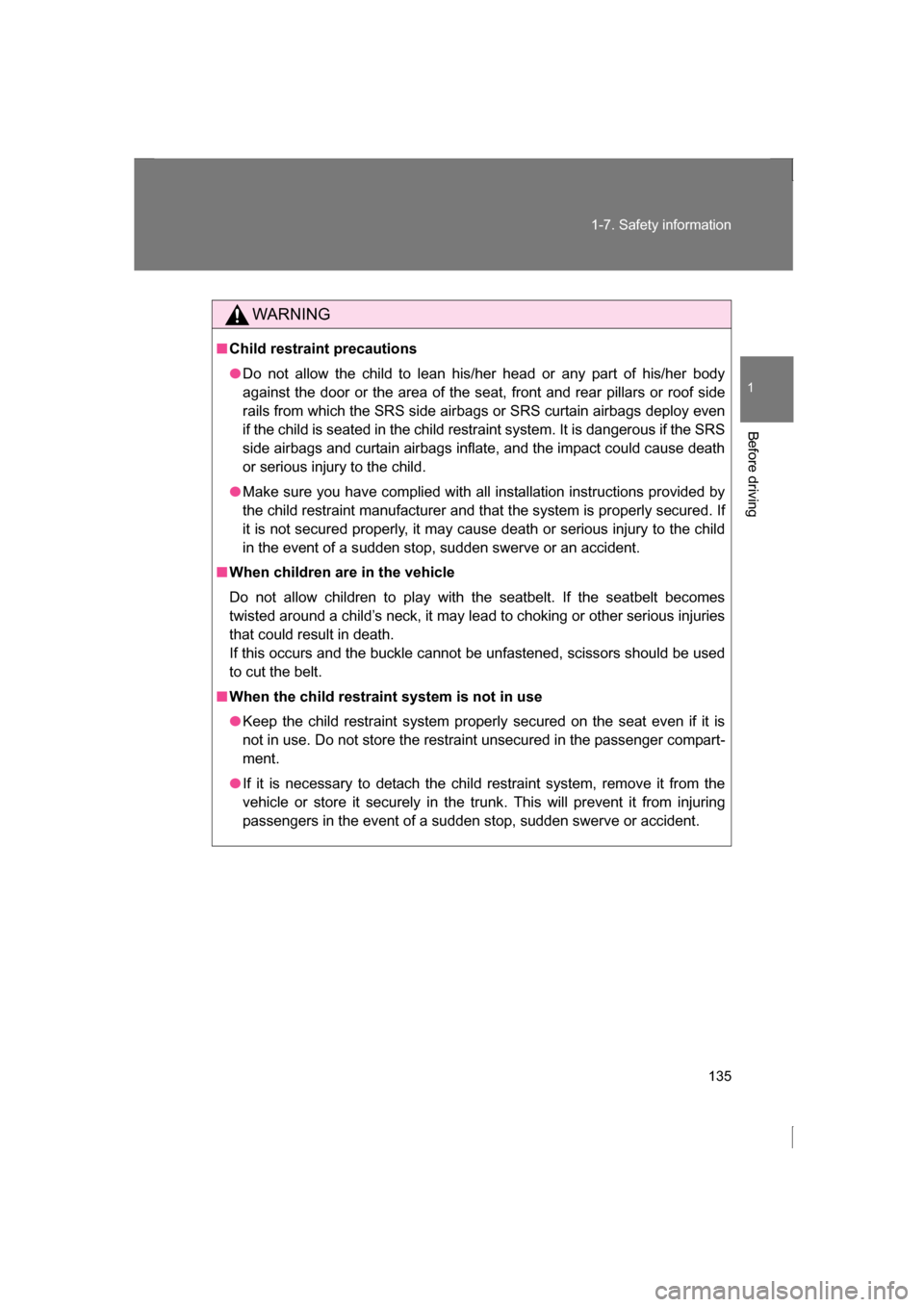
135
1-7. Safety information
1
Before driving
WARNING
■Child restraint precautions
●Do not allow the child to lean his/her head or any part of his/her body
against the door or the area of the seat, front and rear pillars or roof side
rails from which the SRS side airbags or SRS curtain airbags deploy even
if the child is seated in the child restraint system. It is dangerous if the SRS
side airbags and curtain airbags inflate, and the impact could cause death
or serious injury to the child.
●Make sure you have complied with all installation instructions provided by
the child restraint manufacturer and that the system is properly secured. If
it is not secured properly, it may cause death or serious injury to the child
in the event of a sudden stop, sudden swerve or an accident.
■When children are in the vehicle
Do not allow children to play with the seatbelt. If the seatbelt becomes
twisted around a child’s neck, it may lead to choking or other serious injuries
that could result in death.
If this occurs and the buckle cannot be unfastened, scissors should be used
to cut the belt.
■When the child restraint system is not in use
●Keep the child restraint system properly secured on the seat even if it is
not in use. Do not store the restraint unsecured in the passenger compart-ment.
●If it is necessary to detach the child restraint system, remove it from the
vehicle or store it securely in the trunk. This will prevent it from injuring
passengers in the event of a sudden stop, sudden swerve or accident.
Page 136 of 484
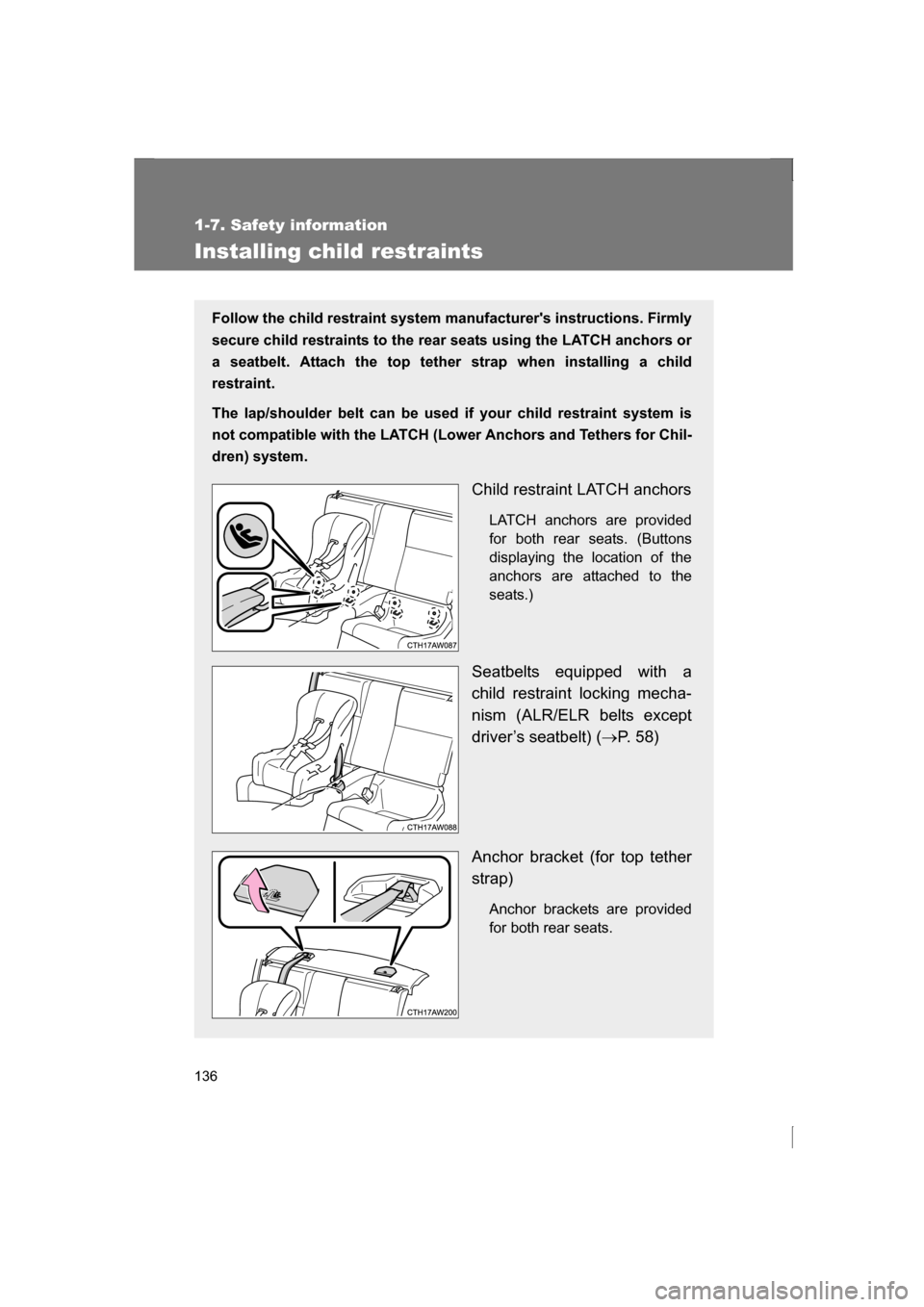
136
1-7. Safety information
Installing child restraints
Follow the child restraint system manufacturer's instructions. Firmly
secure child restraints to the rear seats using the LATCH anchors or
a seatbelt. Attach the top tether strap when installing a child
restraint.
The lap/shoulder belt can be used if your child restraint system is
not compatible with the LATCH (Lower Anchors and Tethers for Chil-
dren) system.
Child restraint LATCH anchorsLATCH anchors are provided
for both rear seats. (Buttons
displaying the location of the
anchors are attached to the
seats.)
Seatbelts equipped with a
child restraint locking mecha-
nism (ALR/ELR belts except
driver’s seatbelt) ( →P. 5 8 )
Anchor bracket (for top tether
strap) Anchor brackets are provided
for both rear seats.
Page 137 of 484
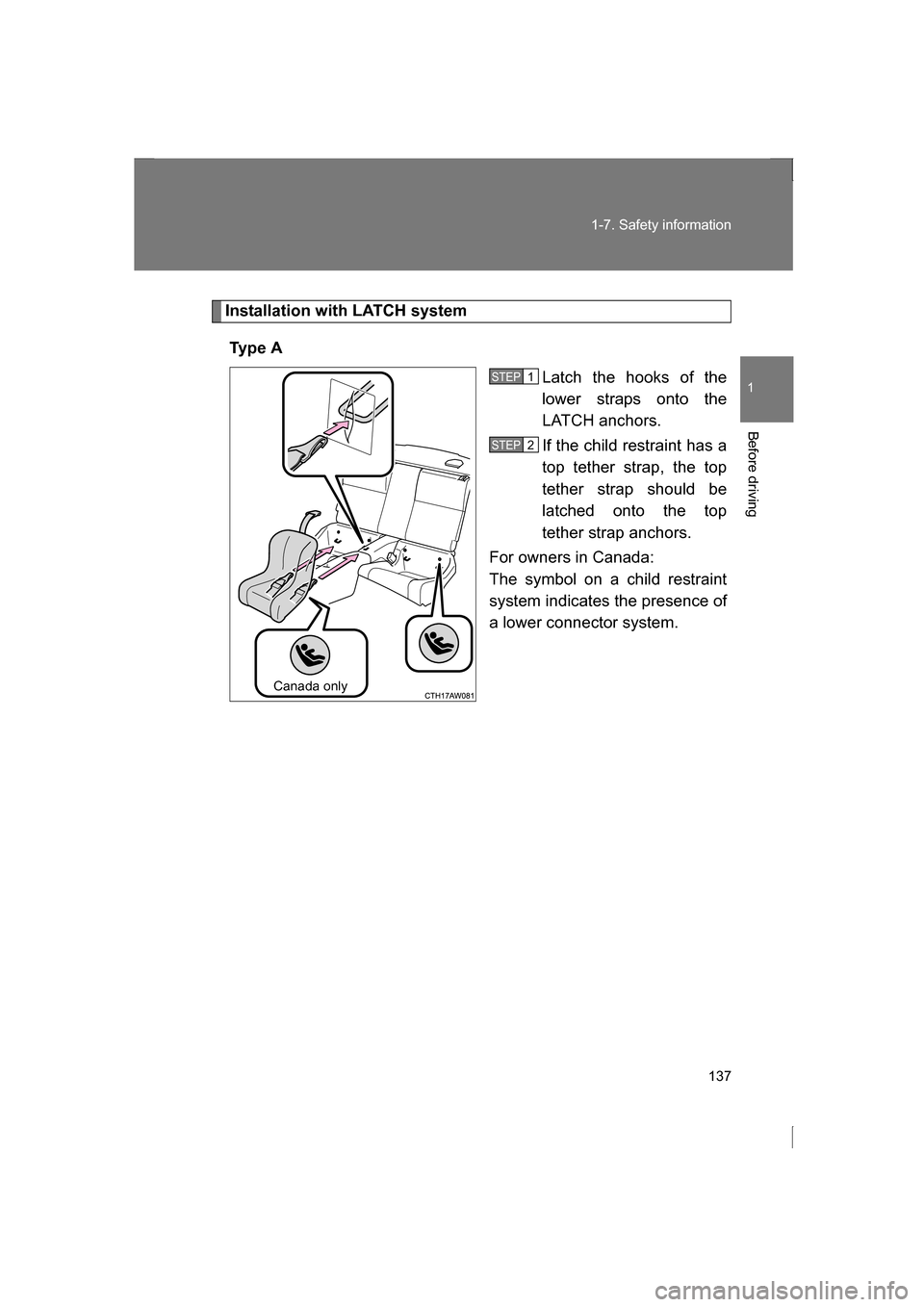
137
1-7. Safety information
1
Before driving
Installation with LATCH systemTy p e A Latch the hooks of the
lower straps onto the
LATCH anchors.
If the child restraint has a
top tether strap, the top
tether strap should be
latched onto the top
tether strap anchors.
For owners in Canada:
The symbol on a child restraint
system indicates the presence of
a lower connector system.
Canada only
STEP 1
STEP 2
Page 138 of 484
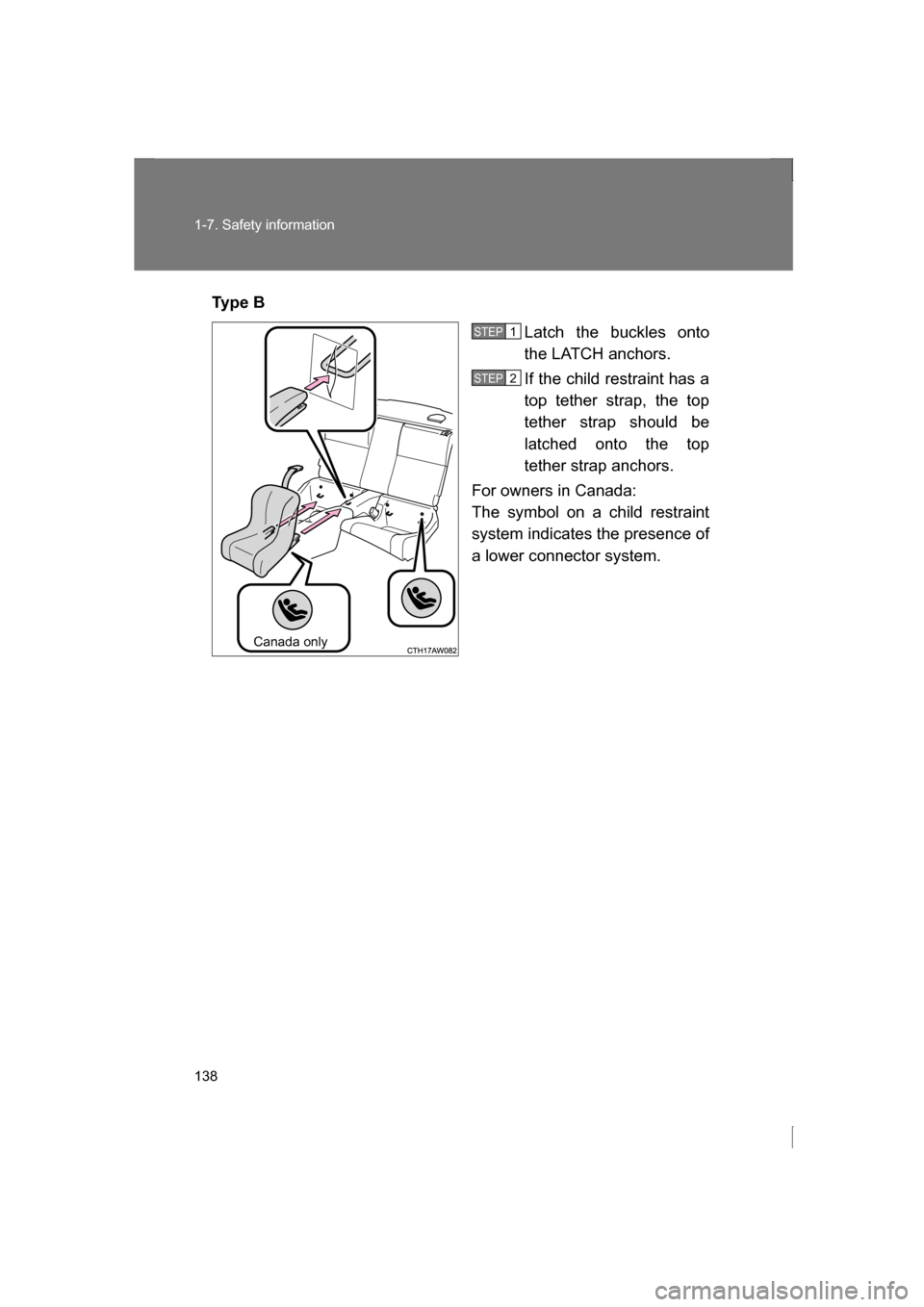
138
1-7. Safety information
Ty p e BLatch the buckles onto
the LATCH anchors.
If the child restraint has a
top tether strap, the top
tether strap should be
latched onto the top
tether strap anchors.
For owners in Canada:
The symbol on a child restraint
system indicates the presence of
a lower connector system.
Canada only
STEP 1
STEP 2
Page 139 of 484
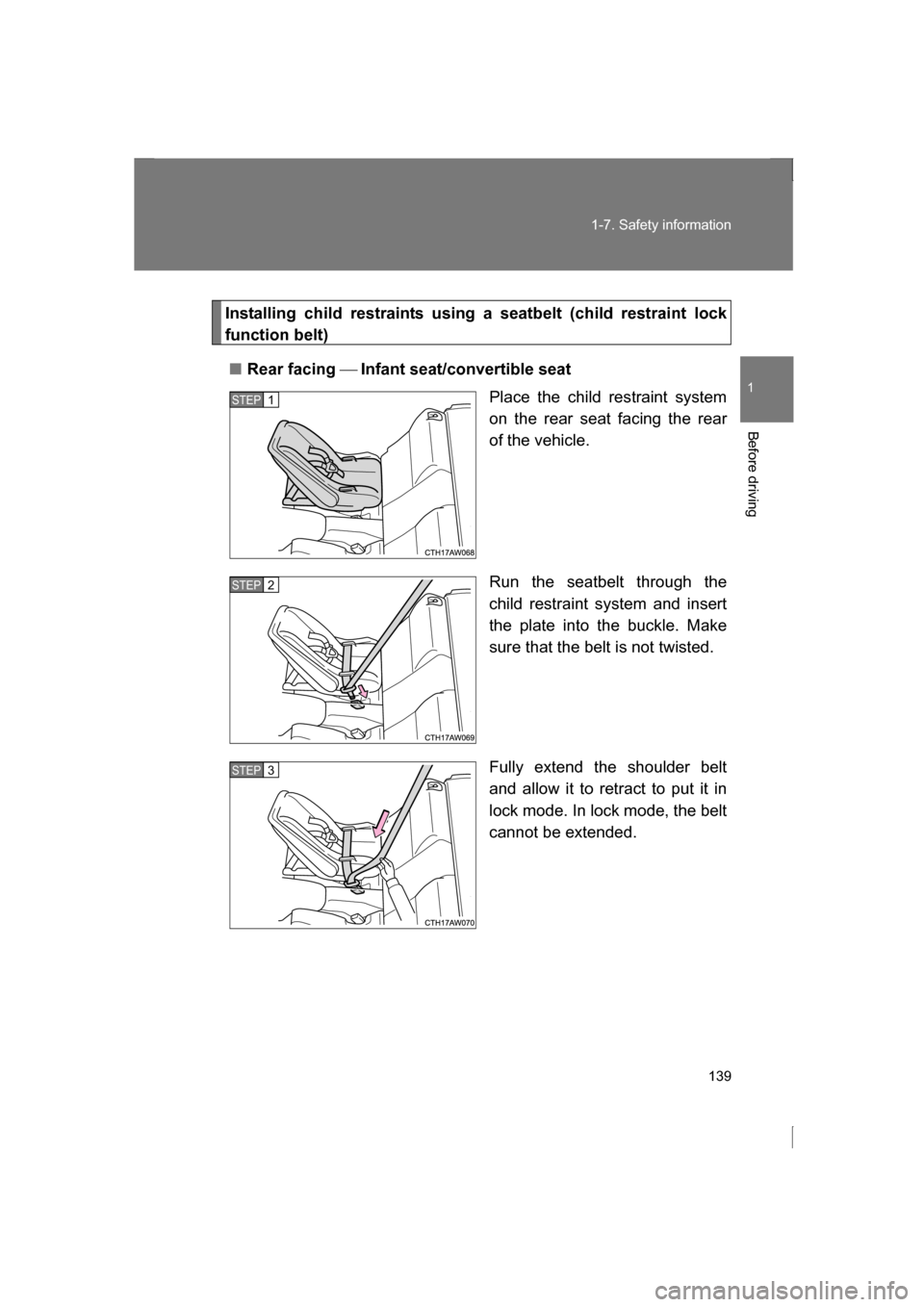
139
1-7. Safety information
1
Before driving
Installing child restraints using a seatbelt (child restraint lock
function belt)
■Rear facing Infant seat/convertible seat
Place the child restraint system
on the rear seat facing the rear
of the vehicle.
Run the seatbelt through the
child restraint system and insert
the plate into the buckle. Make
sure that the belt is not twisted.
Fully extend the shoulder belt
and allow it to retract to put it in
lock mode. In lock mode, the belt
cannot be extended.
STEP 1
STEP 2
STEP 3
Page 140 of 484
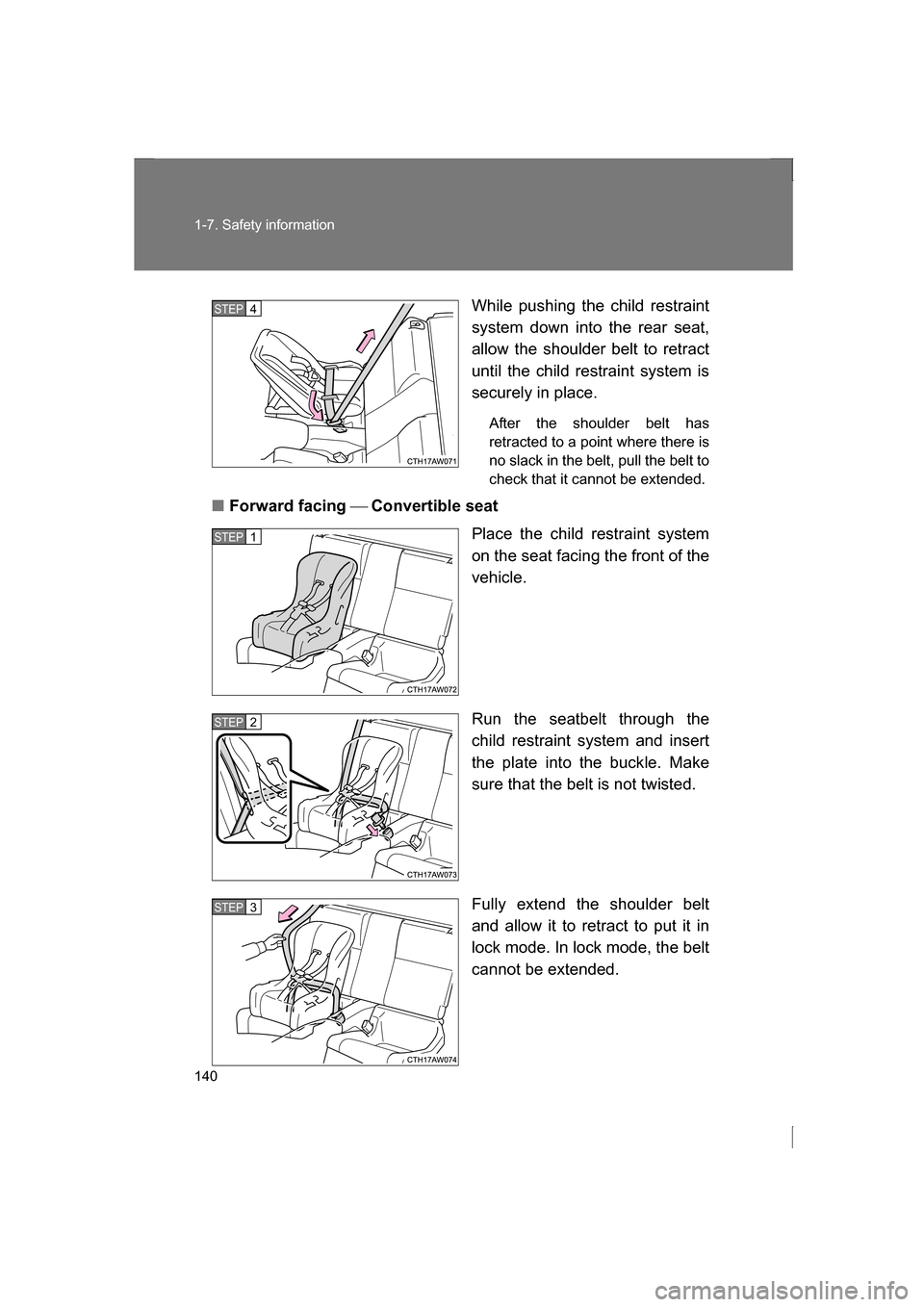
140
1-7. Safety information
While pushing the child restraint
system down into the rear seat,
allow the shoulder belt to retract
until the child restraint system is
securely in place.After the shoulder belt has
retracted to a point where there is
no slack in the belt, pull the belt to
check that it cannot be extended.
■Forward facing Convertible seat
Place the child restraint system
on the seat facing the front of the
vehicle.
Run the seatbelt through the
child restraint system and insert
the plate into the buckle. Make
sure that the belt is not twisted.
Fully extend the shoulder belt
and allow it to retract to put it in
lock mode. In lock mode, the belt
cannot be extended.
STEP 4
STEP 1
STEP 2
STEP 3